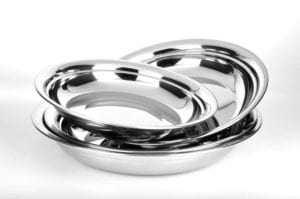Most of the time, when you see stainless steel, chances are it’s either 304 or 316. So what is the difference between these two metals and why would you choose one over the other?
The Material Difference between 304 and 316
They have the similar chemical composition with only slight differences in Nickel content.
| 304 | 316 | |
| Chromium | 17.5-20% | 16-18% |
| Nickel | 8-11% | 10-14% |
| Carbon | .08 | .08 |
| Manganese | 2% | 2% |
| Silicon | 1% | .75% |
| Phosphorus | .045% | .045% |
| Sulfur | .03% | .03% |
| Nitrogen | 0 | .10% |
| Molybdenum | 0 | 2-3% |
Two elements make 316 much better than 304 at corrosion resistance, especially with chlorines and marine grade deteriorations.
Application Competition
 304 is ideal for food surfaces as well as kitchen cutlery where 316 is much more fitted towards being used in chemical and salt water.
304 is ideal for food surfaces as well as kitchen cutlery where 316 is much more fitted towards being used in chemical and salt water.
That doesn’t mean that 316 can’t belong in food service, nor that one would be advantageous over the other, but more often than not, it is just more cost-effective to go with 304 over 316.
Additionally, 316 may sometimes be preferred over 304 in industries such as pharmaceuticals because of their high corrosion resistance. This helps keep strong metals out of medicines.
Stainless Shapes
Remember, both of these are heavily used for everything. Take a look around you; chances are there is 304 stainless all around you
If you have any more questions about 304 and 316, be sure to call us today!

